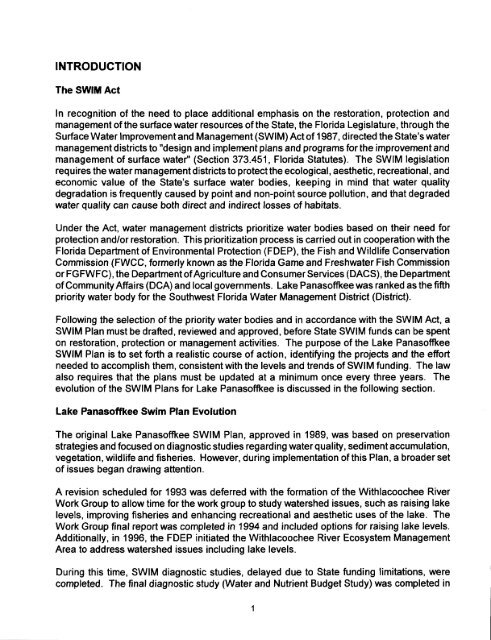Lake Panasoffkee SWIM Plan - Southwest Florida Water ...
Lake Panasoffkee SWIM Plan - Southwest Florida Water ...
Lake Panasoffkee SWIM Plan - Southwest Florida Water ...
Create successful ePaper yourself
Turn your PDF publications into a flip-book with our unique Google optimized e-Paper software.
INTRODUCTION<br />
The <strong>SWIM</strong> Act<br />
In recognition of the need to place additional emphasis on the restoration, protection and<br />
management of the surface water resources of the State, the <strong>Florida</strong> Legislature, through the<br />
Surface <strong>Water</strong> Improvement and Management (<strong>SWIM</strong>) Act of 1987, directed the State's water<br />
management districts to "design and implement plans and programs for the improvement and<br />
management of surface water" (Section 373.451, <strong>Florida</strong> Statutes). The <strong>SWIM</strong> legislation<br />
requires the water management districts to protect the ecological, aesthetic, recreational, and<br />
economic value of the State's surface water bodies, keeping in mind that water quality<br />
degradation is frequently caused by point and non-point source pollution, and that degraded<br />
water quality can cause both direct and indirect losses of habitats.<br />
Under the Act, water management districts prioritize water bodies based on their need for<br />
protection and/or restoration. This prioritization process is carried out in cooperation with the<br />
<strong>Florida</strong> Department of Environmental Protection (FDEP), the Fish and Wildlife Conservation<br />
Commission (FWCC, formerly known as the <strong>Florida</strong> Game and Freshwater Fish Commission<br />
or FGFWFC), the Department ofAgriculture and Consumer Services (DACS), the Department<br />
of Community Affairs (DCA) and local governments. <strong>Lake</strong> PanasofFkee was ranked as the fifth<br />
priority water body for the <strong>Southwest</strong> <strong>Florida</strong> <strong>Water</strong> Management District (District).<br />
Following the selection of the priority water bodies and in accordance with the <strong>SWIM</strong> Act, a<br />
<strong>SWIM</strong> <strong>Plan</strong> must be drafted, reviewed and approved, before State <strong>SWIM</strong> funds can be spent<br />
on restoration, protection or management activities. The purpose of the <strong>Lake</strong> <strong>Panasoffkee</strong><br />
<strong>SWIM</strong> <strong>Plan</strong> is to set forth a realistic course of action, identifying the projects and the effort<br />
needed to accomplish them, consistent with the levels and trends of <strong>SWIM</strong> funding. The law<br />
also requires that the plans must be updated at a minimum once every three years. The<br />
evolution of the <strong>SWIM</strong> <strong>Plan</strong>s for <strong>Lake</strong> Panasornee is discussed in the following section.<br />
<strong>Lake</strong> <strong>Panasoffkee</strong> Swim <strong>Plan</strong> Evolution<br />
The original <strong>Lake</strong> PanasofFkee <strong>SWIM</strong> <strong>Plan</strong>, approved in 1989, was based on preservation<br />
strategies and focused on diagnostic studies regarding water quality, sediment accumulation,<br />
vegetation, wildlife and fisheries. However, during implementation of this <strong>Plan</strong>, a broader set<br />
of issues began drawing attention.<br />
A revision scheduled for 1993 was deferred with the formation of the Withlacoochee River<br />
Work Group to allow time for the work group to study watershed issues, such as raising lake<br />
levels, improving fisheries and enhancing recreational and aesthetic uses of the lake. The<br />
Work Group final report was completed in 1994 and included options for raising lake levels.<br />
Additionally, in 1996, the FDEP initiated the Withlacoochee River Ecosystem Management<br />
Area to address watershed issues including lake levels.<br />
During this time, <strong>SWIM</strong> diagnostic studies, delayed due to State funding limitations, were<br />
completed. The final diagnostic study (<strong>Water</strong> and Nutrient Budget Study) was completed in<br />
1
















